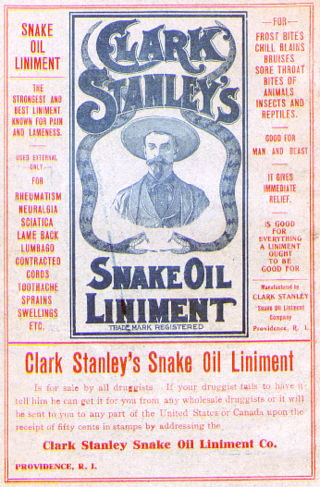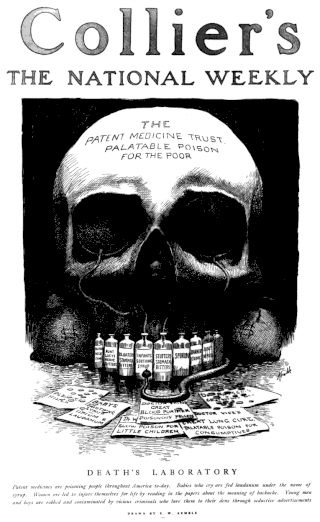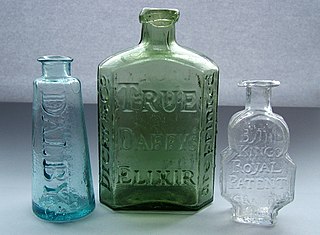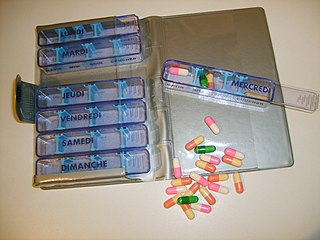
Turlington's Balsam of Life was a patent medicine developed by English merchant Robert Turlington.

Turlington's Balsam of Life was a patent medicine developed by English merchant Robert Turlington.
He succeeded in obtaining a royal patent from King George II in 1744, which gave him the right to pursue anyone attempting to pass off their own product as his, [1] one of the earliest medicinal patents. [2] [lower-alpha 1] In his patent application Turlington claimed that the balsam contained 27 ingredients, and was effective in the treatment of "kidney and bladder stones, cholic, and inward weakness", a list of ailments he greatly expanded upon in a 46-page brochure printed shortly afterwards. [4] Turlington's Balsam quickly became popular in England and in the American colonies. [1]
During the 17th and 18th centuries, the manufacturers of patent medicines began to use packaging as a tool to differentiate their products from those of their competitors, as there was often little to visually distinguish between the medications themselves. [lower-alpha 2] In Turlington's case that resulted in his changing the shape of the bottle containing his balsam at least four times in the ten years following the granting of his patent, culminating in an elaborately embossed tablet-shaped bottle introduced in 1754. [5]

Snake oil is a term used to describe deceptive marketing, health care fraud, or a scam. Similarly, snake oil salesman is a common label used to describe someone who sells, promotes, or is a general proponent of some valueless or fraudulent cure, remedy, or solution. The term comes from the "snake oil" that used to be sold as a cure-all elixir for many kinds of physiological problems. Many 19th-century United States and 18th-century European entrepreneurs advertised and sold mineral oil as "snake oil liniment", making claims about its efficacy as a panacea. Patent medicines that claimed to be a panacea were extremely common from the 18th century until the 20th, particularly among vendors masking addictive drugs such as cocaine, amphetamine, alcohol, and opium-based concoctions or elixirs, to be sold at medicine shows as medication or products promoting health.

A medication is a drug used to diagnose, cure, treat, or prevent disease. Drug therapy (pharmacotherapy) is an important part of the medical field and relies on the science of pharmacology for continual advancement and on pharmacy for appropriate management.

Quackery, often synonymous with health fraud, is the promotion of fraudulent or ignorant medical practices. A quack is a "fraudulent or ignorant pretender to medical skill" or "a person who pretends, professionally or publicly, to have skill, knowledge, qualification or credentials they do not possess; a charlatan or snake oil salesman". The term quack is a clipped form of the archaic term quacksalver, derived from Dutch: kwakzalver a "hawker of salve" or rather somebody who boasted about their ‘salves’, more commonly known as ointments. In the Middle Ages the term quack meant "shouting". The quacksalvers sold their wares at markets by shouting to gain attention.

A bitters is traditionally an alcoholic preparation flavored with botanical matter for a bitter or bittersweet flavor. Originally, numerous longstanding brands of bitters were developed as patent medicines, but now are sold as digestifs, sometimes with herbal properties, and as cocktail flavorings.

Pharmacy is the science and practice of discovering, producing, preparing, dispensing, reviewing and monitoring medications, aiming to ensure the safe, effective, and affordable use of medicines. It is a miscellaneous science as it links health sciences with pharmaceutical sciences and natural sciences. The professional practice is becoming more clinically oriented as most of the drugs are now manufactured by pharmaceutical industries. Based on the setting, pharmacy practice is either classified as community or institutional pharmacy. Providing direct patient care in the community of institutional pharmacies is considered clinical pharmacy.

A patent medicine is a non-prescription medicine or medicinal preparation that is typically protected and advertised by a trademark and trade name, and claimed to be effective against minor disorders and symptoms, as opposed to a prescription drug that could be obtained only through a pharmacist, usually with a doctor's prescription, and whose composition was openly disclosed. Many over-the-counter medicines were once ethical drugs obtainable only by prescription, and thus are not patent medicines.
Dr. Reddy's Laboratories is an Indian multinational pharmaceutical company based in Hyderabad. The company was founded by Kallam Anji Reddy, who previously worked in the mentor institute Indian Drugs and Pharmaceuticals Limited. Dr. Reddy manufactures and markets a wide range of pharmaceuticals in India and overseas. The company produces over 190 medications, 60 active pharmaceutical ingredients (APIs) for drug manufacture, diagnostic kits, critical care, and biotechnology.
A biopharmaceutical, also known as a biological medical product, or biologic, is any pharmaceutical drug product manufactured in, extracted from, or semisynthesized from biological sources. Different from totally synthesized pharmaceuticals, they include vaccines, whole blood, blood components, allergenics, somatic cells, gene therapies, tissues, recombinant therapeutic protein, and living medicines used in cell therapy. Biologics can be composed of sugars, proteins, nucleic acids, or complex combinations of these substances, or may be living cells or tissues. They are isolated from living sources—human, animal, plant, fungal, or microbial. They can be used in both human and animal medicine.

Dalby's Carminative was one of the two most widely used patent medicines given to babies and children at the end of the 18th and beginning of the 19th centuries. Together with its rival, Godfrey's Cordial, they were known as "mother's friends" and were used for everything from colic and coughs to typhoid.

An auxiliary label is a label added on to a dispensed medication package by a pharmacist in addition to the usual prescription label. These labels are intended to provide supplementary information regarding the safe administration, use, and storage of the medication. Auxiliary labels provide information which can augment but not replace verbal counselling from a pharmacist.
A veterinary pharmacist is a specially trained pharmacist who dispenses veterinary drugs and supplies or products and advice to owners of companion animals and livestock. In addition, they advise the regulatory bodies and are involved in the formulation of veterinary drugs. Veterinary pharmacy is a field of pharmacy practice, in which veterinary pharmacists may compound medications, fill prescriptions, and manage drug therapies for animals. Veterinary pharmacists are licensed pharmacists who specialize in the distribution of medications for animals.

The Remington Honor Medal, named for eminent community pharmacist, manufacturer, and educator Joseph P. Remington (1847–1918), was established in 1918 to recognize distinguished service on behalf of American pharmacy during the preceding year, culminating in the past year, or during a long period of outstanding activity or fruitful achievement.

A show globe is a glass vessel of various shapes and sizes containing a colorful liquid. It has been a symbol of pharmacy from the 17th century England to the early 20th century in the United States. It marked the drugstore or apothecary in much the same way as the barber's pole marked tonsorial establishments in some countries. People who were illiterate needed such symbols to locate these medical practitioners.

A pill organiser, pill container, dosette box, pillcase or pillbox is a multicompartment compliance aid for storing scheduled doses of medications. Pill organisers usually have square-shaped compartments for each day of the week, although other more compact and discreet versions have come to market, including cylindrical and pen-shaped cases. Some organisers have sections corresponding to times of the day. Pill organisers are viewed as a way to prevent or reduce medication errors on the part of the patient, though evidence of effectiveness is not strong and they have been linked to medication errors.
Pharmacy automation involves the mechanical processes of handling and distributing medications. Any pharmacy task may be involved, including counting small objects ; measuring and mixing powders and liquids for compounding; tracking and updating customer information in databases ; and inventory management. This article focuses on the changes that have taken place in the local, or community pharmacy since the 1960s.
A medicinal jar, drug jar, or apothecary jar is a jar used to contain medicines. Ceramic medicinal jars originated in the Islamic world and were brought to Europe where the production of jars flourished from the Middle Ages onward. Potteries were established throughout Europe and many were commissioned to produce jars for pharmacies and monasteries. They are an important category of the Dutch and English porcelain known as Delftware.

Drug packaging is process of packing pharmaceutical preparations for distribution, and the physical packaging in which they are stored. It involves all of the operations from production through drug distribution channels to the end consumer.

The history of pharmacy as a modern and independent science dates back to the first third of the 19th century. Before then, pharmacy evolved from antiquity as part of medicine. The history of pharmacy coincides well with the history of medicine, but it's important that there is a distinction between the two topics. Pharmaceuticals is one of the most-researched fields in the academic industry, but the history surrounding that particular topic is sparse compared to the impact its made world-wide. Before the advent of pharmacists, there existed apothecaries that worked alongside priests and physicians in regard to patient care.

The history of pharmacy in the United States is the story of a melting pot of new pharmaceutical ideas and innovations drawn from advancements that Europeans shared, Native American medicine and newly discovered medicinal plants in the New World. American pharmacy grew from this fertile mixture, and has impacted U.S. history, and the global course of pharmacy.